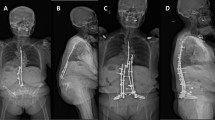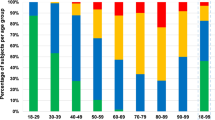Abstract
Purpose
To determine whether radiological, clinical, and demographic findings in patients with cervical spondylotic myelopathy (CSM) were independently associated with loss of cervical lordosis (LCL) after laminoplasty.
Methods
The prospective study included 41 consecutive patients who underwent laminoplasty for CSM. The difference in C2-7 Cobb angle between the postoperative and preoperative films was used to evaluate change in cervical alignment. Age, sex, body mass index (BMI), smoking history, preoperative C2-7 Cobb angle, T1 slope, C2-7 range of motion (C2-7 ROM), C2-7 sagittal vertical axis (C2-7 SVA), and cephalad vertebral level undergoing laminoplasty (CVLL) were assessed. Data were analyzed using Pearson and Spearman correlation test, and univariate and stepwise multivariate linear regression.
Results
T1 slope, C2-7 SVA, and CVLL significantly correlated with LCL (P < 0.001), whereas age, BMI, and preoperative C2-7 Cobb angle did not. In multiple linear regression analysis, higher T1 slope (B = 0.351, P = 0.037), greater C2-7 SVA (B = 0.393, P < 0.001), and starting laminoplasty at C4 level (B = − 7.038, P < 0.001) were significantly associated with higher postoperative LCL.
Conclusions
Cervical alignment was compromised after laminoplasty in patients with CSM, and the degree of LCL was associated with preoperative T1 slope, C2-7 SVA, and CVLL.

Similar content being viewed by others
References
Kimura I, Shingu H, Nasu Y (1995) Long-term follow-up of cervical spondylotic myelopathy treated by canal-expansive laminoplasty. J Bone Jt Surg Br 77(6):956–961
Suda K, Abumi K, Ito M et al (2003) Local kyphosis reduces surgical outcomes of expansive open-door laminoplasty for cervical spondylotic myelopathy. Spine (Phila Pa 1976) 28(12):1258–1262
Aita I, Wadano Y, Yabuki T (2000) Curvature and range of motion of the cervical spine after laminaplasty. J Bone Jt Surg Am 82(12):1743–1748
Baba H, Uchida K, Maezawa Y et al (1996) Lordotic alignment and posterior migration of the spinal cord following en bloc open-door laminoplasty for cervical myelopathy: a magnetic resonance imaging study. J Neurol 243(9):626–632
Taniyama T, Hirai T, Yoshii T et al (2014) Modified K-line in magnetic resonance imaging predicts clinical outcome in patients with nonlordotic alignment after laminoplasty for cervical spondylotic myelopathy. Spine (Phila Pa 1976) 39(21):E1261–E1268
Suk KS, Kim KT, Lee JH et al (2007) Sagittal alignment of the cervical spine after the laminoplasty. Spine (Phila Pa 1976) 32(23):E656–E660
Kim TH, Lee SY, Kim YC, Park MS, Kim SW (2013) T1 slope as a predictor of kyphotic alignment change after laminoplasty in patients with cervical myelopathy. Spine (Phila Pa 1976) 38(16):E992–E997
Michael KW, Neustein TM, Rhee JM (2016) Where should a laminoplasty start? The effect of the proximal level on post-laminoplasty loss of lordosis. Spine J 16(6):737–741
Machino M, Yukawa Y, Hida T et al (2012) Cervical alignment and range of motion after laminoplasty: radiographical data from more than 500 cases with cervical spondylotic myelopathy and a review of the literature. Spine (Phila Pa 1976) 37(20):E1243–E1250
Yukawa Y, Kato F, Ito K et al (2007) Laminoplasty and skip laminectomy for cervical compressive myelopathy: range of motion, postoperative neck pain, and surgical outcomes in a randomized prospective study. Spine (Phila Pa 1976) 32(18):1980–1985
Fujimura Y, Nishi Y (1996) Atrophy of the nuchal muscle and change in cervical curvature after expansive open-door laminoplasty. Arch Orthop Trauma Surg 115(3–4):203–205
Kawaguchi Y, Kanamori M, Ishihara H et al (2003) Minimum 10-year followup after en bloc cervical laminoplasty. Clin Orthop Relat Res 411:129–139
Ratliff JK, Cooper PR (2003) Cervical laminoplasty: a critical review. J Neurosurg 98(3 Suppl):230–238
Tang JA, Scheer JK, Smith JS et al (2012) The impact of standing regional cervical sagittal alignment on outcomes in posterior cervical fusion surgery. Neurosurgery 71(3):662–669 (discussion 669)
Sakai K, Yoshii T, Hirai T et al (2016) Impact of the surgical treatment for degenerative cervical myelopathy on the preoperative cervical sagittal balance: a review of prospective comparative cohort between anterior decompression with fusion and laminoplasty. Eur Spine J (Epub ahead of print)
Kim B, Yoon DH, Ha Y et al (2016) Relationship between T1 slope and loss of lordosis after laminoplasty in patients with cervical ossification of the posterior longitudinal ligament. Spine J 16(2):219–225
Ames CP, Blondel B, Scheer JK et al (2013) Cervical radiographical alignment: comprehensive assessment techniques and potential importance in cervical myelopathy. Spine (Phila Pa 1976) 38(22 Suppl 1):S149–S160
Sakai K, Yoshii T, Hirai T et al (2016) Cervical sagittal imbalance is a predictor of kyphotic deformity after laminoplasty in cervical spondylotic myelopathy patients without preoperative kyphotic alignment. Spine (Phila Pa 1976) 41(4):299–305
Cho JH, Ha JK, Kim DG et al (2014) Does preoperative T1 slope affect radiological and functional outcomes after cervical laminoplasty? Spine (Phila Pa 1976) 39(26):E1575–E1581
Iizuka H, Shimizu T, Tateno K et al (2001) Extensor musculature of the cervical spine after laminoplasty: morphologic evaluation by coronal view of the magnetic resonance image. Spine (Phila Pa 1976) 26(20):2220–2226
Lin S, Zhou F, Sun Y et al (2015) The severity of operative invasion to the posterior muscular-ligament complex influences cervical sagittal balance after open-door laminoplasty. Eur Spine J 24(1):127–135
Iizuka H, Nakajima T, Iizuka Y et al (2007) Cervical malalignment after laminoplasty: relationship to deep extensor musculature of the cervical spine and neurological outcome. J Neurosurg Spine 7(6):610–614
Acknowledgements
We thank Dr. Jie Li for his assistance in the statistical analysis.
Author information
Authors and Affiliations
Corresponding author
Ethics declarations
Conflicts of interest
The author(s) declare that they have no competing interests.
Rights and permissions
About this article
Cite this article
Zhang, J.T., Li, J.Q., Niu, R.J. et al. Predictors of cervical lordosis loss after laminoplasty in patients with cervical spondylotic myelopathy. Eur Spine J 26, 1205–1210 (2017). https://doi.org/10.1007/s00586-017-4971-4
Received:
Revised:
Accepted:
Published:
Issue Date:
DOI: https://doi.org/10.1007/s00586-017-4971-4




